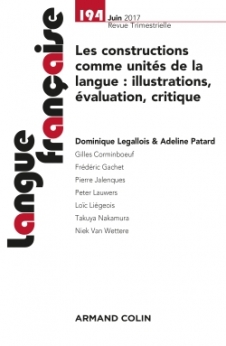
Langue française n° 194 (2/2017)
Pour acheter ce numéro, contactez-nous
Recevez les numéros de l'année en cours et accédez à l'intégralité des articles en ligne.
Cet article explore les « voies de grammaticalisation primaire » d’une paire de verbes attributifs exprimant un changement d’état, à savoir tourner/virer, à l’aide de la « boîte à outils » de la Grammaire constructionnelle diachronique. Fondamentalement, deux mécanismes de constructionnalisation jouent un rôle important dans le processus de copularisation : (i) l’interaction entre les micro-constructions prépositionnelles d’un emploi déjà désémantisé du verbe et leur micro-construction semi-copulative correspondante et (ii) l’attraction lexicale exercée par un verbe synonymique qui attire d’autres verbes dans le spectre de la construction attributive (cf. analogisation).
This article explores “the pathways of incipient grammaticalization” of a pair of change-ofstate semi-copulas tourner/virer ‘become’ (<‘turn’), within a Diachronic Construction Grammar–framework. Crucially, two mechanisms of constructionalization play an important role in the process of copularization: (i) the interaction between oblique micro-constructions of an already bleached usage of the verb and their corresponding semi-copular micro-construction and (ii) the lexical attraction exerted by a synonymic verb that attracts new verbs into the semi-copular construction (cf. analogization).